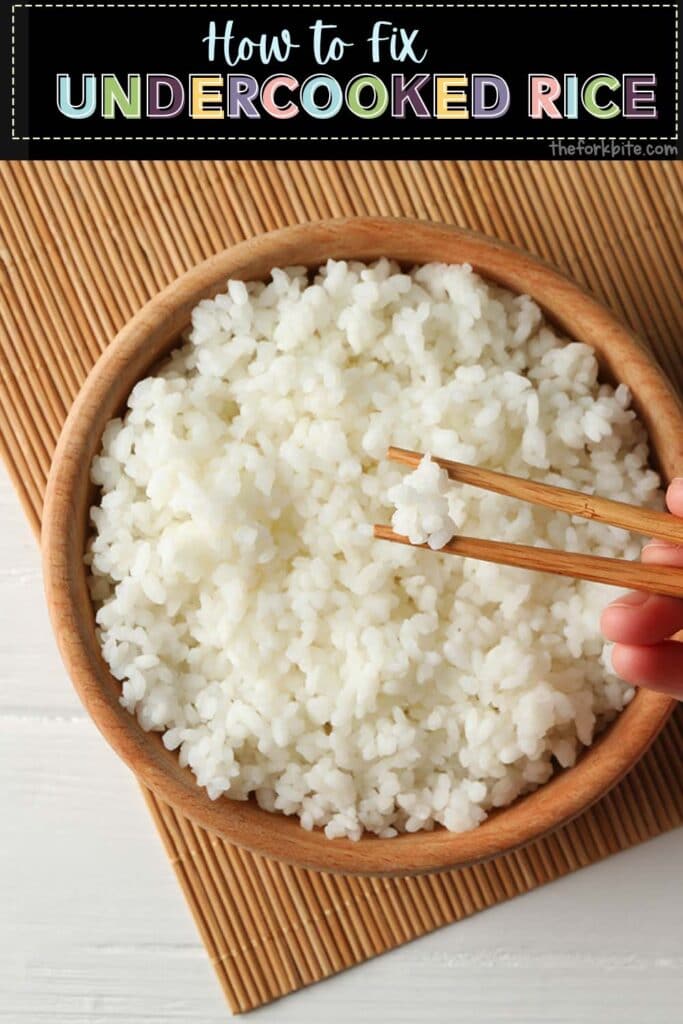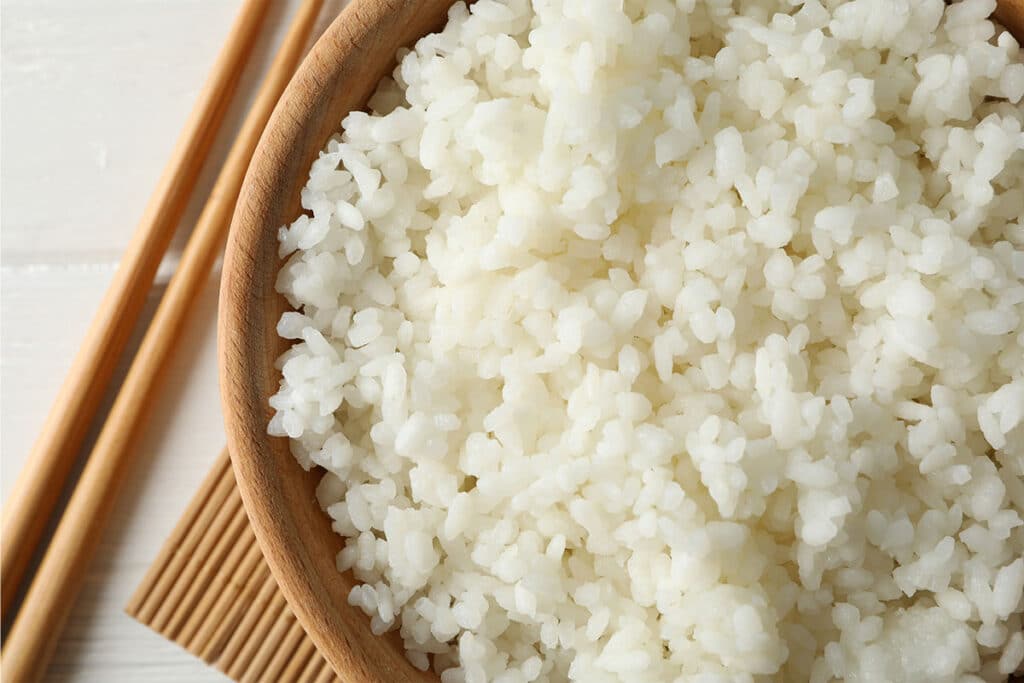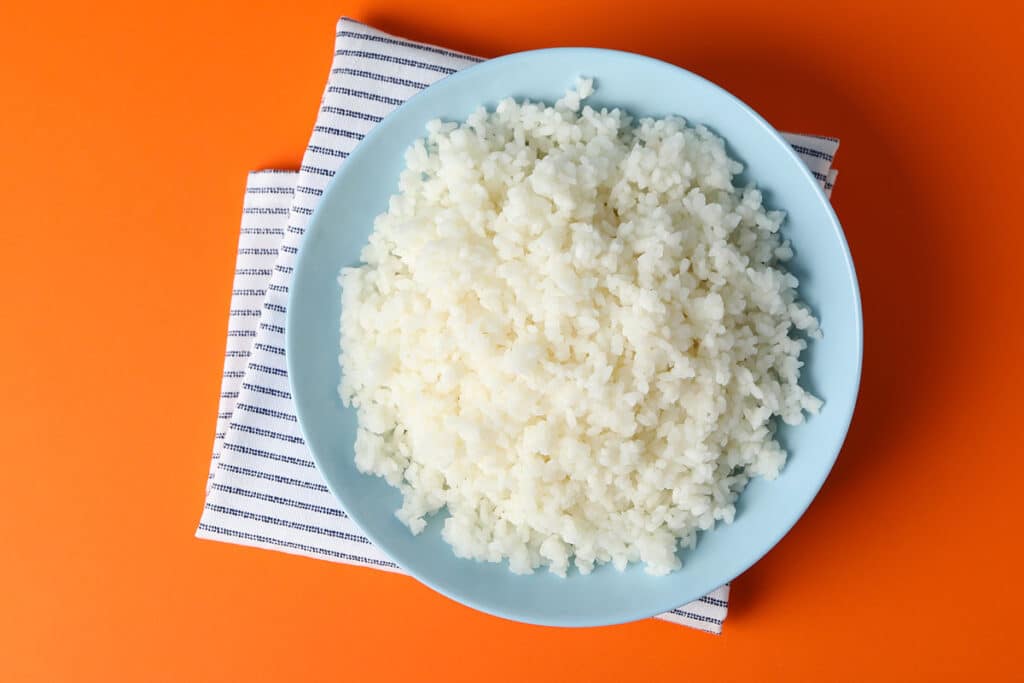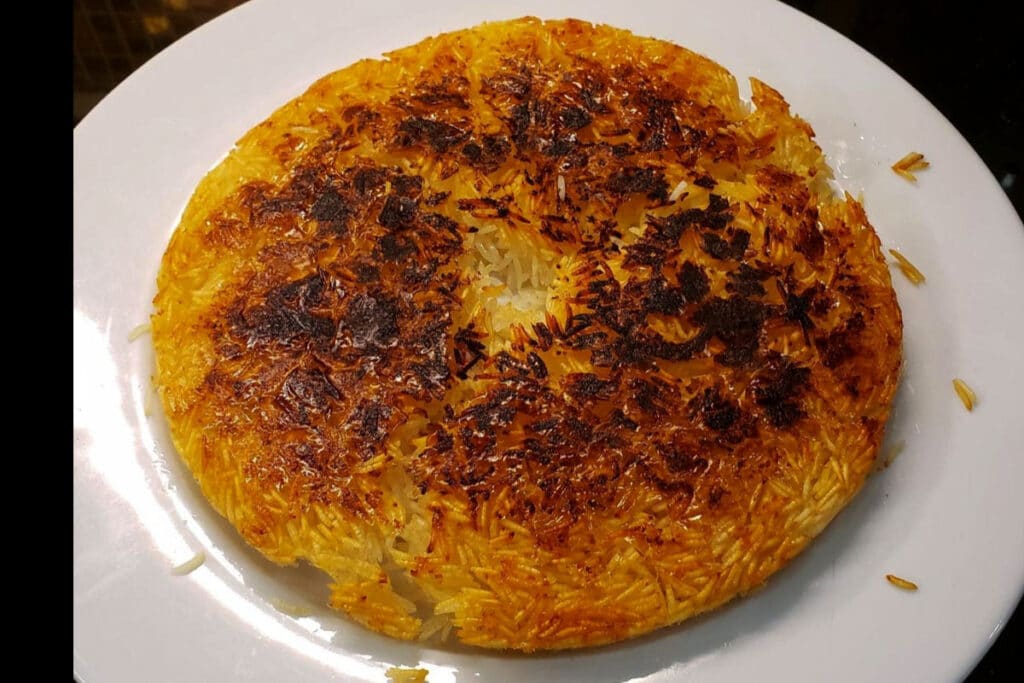how to fix undercooked rice
If you have to ask yourself why your rice is mushy or sticky (or undercooked), this guide will help to explain why and assist you in fixing the mistakes that led to the problem, enabling you to make a perfect batch of rice every time.
Problems with the way rice turns out when you've cooked are usually down to how long you cooked it for, at what temperature, and in what vessel.
These factors vary from stove to stove and kitchen to kitchen, but the fact of the matter remains that it's incredibly easy to cook rice incorrectly.

Jump to:
- How to fix undercooked rice
- 8 steps to follow to cook perfect rice on your stovetop
- Frequently asked questions
Cook it on too high a heat, and it will burn, boil over, or end up as a porridge-like mess rather than the soft fluffy cloud of rice for which you were hoping.
The most common problem, however, is undercooked rice. If that happens, all is not lost; you can still enjoy nicely cooked rice if you follow what I'm about to tell you.
How to tell if rice is undercooked or overcooked?
Let's start with understanding how to identify when rice is undercooked.
This part of the article aims at people who do not have much experience with cooking rice.
Although it's not rocket science, it is remarkably easy to get it wrong and end up with under or overcooked rice.

What is undercooked rice?
The water generally causes undercooked rice to boil and evaporate before the rice grains have cooked through to the center.
In other words, they are still hard in the middle. You can actually tell this before eating it by pressing a grain of rice between your finger and thumb.
If the outer part of the grain is easy to squeeze, but the inner isn't, it's undercooked.
This isn't the only tell-tale sign. More often than not, undercooked rice is often hard and crusty.
How to tell if rice is overcooked
When the rice has been overcooked, the grains are usually mushy. It is the result of the grains splitting and releasing the starch they contain.
The result is usually sticky, gooey rice that all clumps together.
If it's just a case of the rice being sticky, it is still possible to save it.
All you have to do is transfer it from the pan into a colander and run cool water through it while separating the grains simultaneously with your fingers.
If, however, the rice is very mushy, there's not a lot you can do. It's best to start over and do another batch.
But don't throw the mushy rice away. There are several things for which you can use it.
For example, use it to make fried rice or turn it into fritters or patties.
The good news is, you can even use it to make veggie burgers. You can even add and cook it further in soup dishes to give them a little more substance.
How to fix undercooked rice
A common problem that results in undercooked rice is cooking it at too high a temperature which causes the water to evaporate before the rice is cooked through.
It could be that you didn't add enough water in the beginning, or you removed the lid from the pan too early, thus allowing the water to evaporate.
Regardless of the cause, if the rice looks dry or it's hard and crunchy, or both, here's what to do:
Step 1
Pour ½ a cup of water over it, put it back on the heat, and allow it to simmer with the lid in position. Don't be tempted to try and rush it by raising the temperature, or you will end up with the same problem again.
Step 2
It's important to ensure the lid is tightly in position. Instead of cooking the rice, the steam will escape if it isn't, leaving the rice undercooked.
Step 3
Leave the lid in position. No peeking. If you do, you'll release all the steam, and you could end up with undercooked rice again.
If you're cooking wild rice (a product that isn't actually rice at all), it takes longer to cook than ordinary rice. It needs simmering for a little bit longer, or it will be too crunchy.
Extra tip:
You can place a sheet of paper kitchen towel between the pan and its lid to seal it and prevent the steam from escaping.
If you try this, make sure the paper towel doesn't get exposed to the burner if you have a gas stove.
Using a rice cooker to remedy undercooked rice
There are several ways of correcting undercooked rice if you're using a rice cooker. Let me explain.
When the switch on your cooker changes from the "cook function" to the "warm mode", before the rice is properly cooked, don't open the lid straight away.
Allow it to stand for a further 10 minutes with the cooker in warm mode.
A lot of people forget to do this and end up with undercooked rice. Allowing the rice to rest for these extra few minutes allows the grains to soak up any leftover water.
After the 10 minutes have elapsed, remove the lid, take out a few grains of rice, then roll them between your thumb and finger to check their texture.
Related article:
How Long Can you Keep Rice in Rice Cooker
How Long Does Sushi Rice Last
Best Way to Reheat Fried Rice
What to do if it's still undercooked?
If, after waiting 10 minutes before removing the lid of the rice cooker, you find the rice is still undercooked, here's what to do:
- Pour half a cup of boiling water over the rice.
- Take a fork and give the rice astir, thus separating the grains, then put the lid back in position.
- Reset the switch of the rice cooker to the "cook" position and let the rice cook for a further 2 to 3 minutes. When the time is up, recheck the rice, and if it is still too hard, repeat the process once more.
- Repeat as many times as necessary.
Don't worry; later on, I will tell you the correct way to cook rice to ensure you don't end up undercooked.

Using a microwave to remedy undercooked rice
Most of us own a microwave, and you can use this handy device to remedy undercooked rice in a trice.
Here's how:
- Transfer the undercooked rice into a microwave-safe bowl or dish.
- Take a few sheets of paper kitchen towel, wet them thoroughly, then squeeze out 20% of the water so they are still wet but not sodden.
- Drape the wet sheets over the bowl, completely covering the contents but not touching them.
- Microwave the rice in two, one-minute blasts. Check to ensure it is now cooked to your satisfaction. This method works due to the moisture in the paper towels turning to hot steam. The steam cannot escape as it is sealed in place by the towel covering, and it finishes cooking the rice to perfection.
- Take the bowl out of the microwave using an oven glove to make sure you don't burn your hands, and carefully remove the paper towel covering as that too will be hot. Fluff the now splendidly cooked rice with a fork and serve.
If you are microwaving a large batch of undercooked rice, you may need to repeat the process once or twice until the rice is done as you like it.
How to fix burnt rice
How burned is the rice? This is the first question to ask yourself. If it's as black as coal, it's beyond repair, so there is nothing to do other than throw it away.
If, however, it is not burnt, but it only appears crisp and smells toasty, why not give it a try?
Countries all over the world rejoice in crispy rice. For example:
- "Nurungji," is famous in Korea. The name for rice that has been roasted or scorched.
- In Spain, locals adore "socarrat" – the rice at the bottom of the pan in which paella is cooked, so it becomes burnt and crispy.
- In Iranian cuisine, "tahdig" translates as "the bottom of the pot." It refers to the crust that forms on the bottom of a rice pot. It is then often broken into shards and sprinkled over a dish to add crunch. When done properly, you should be able to remove tahdig from the bottom of the dish in one complete disc.
So, if you find some toasted brown grains of rice on the bottom of your rice pot, try scraping them off with a wooden spoon (add a tiny drop of water if it is stubbornly stuck), and serve them over your cooked rice for a texture treat.

How to fix watery rice
If the rice you are cooking is done to your liking, but there is still some water in the pan, don't carry on boiling to evaporate it; you'll only overcook the rice.
What you should do is pour the contents into a fine-mesh strainer and let the water escape. Then serve the rice as is.
What to do with mushy rice
When rice absorbs too much water, it can result in grains splitting. When this happens, starches are released that will turn the rice soft and stodgy.
You can't "unglue" the rice, but you can do something else with it.
For example, adding some milk and a pinch of vanilla plus a little sugar can turn that once stodgy rice into a delicious creamy rice pudding.
How to remedy gummy rice
If the grains of rice you cooked are sticking together and they weren't supposed to, it could be because you have not rinsed the rice thoroughly enough before boiling it. It's quite a common problem.
Before you cook rice, you should pour the grains into a sieve and hold it under the cold water tap and flush it through thoroughly, agitating it as you go.
Carry on rinsing until the water coming out through the bottom of the sieve is clear.
One other option after unintentionally cooking sticky rice is to rinse it under the cold water tap to try and get rid of as much starch as you can.
It will obviously cool the rice right down. To warm it up again, spread the rice onto a sheet tray and pop it in an oven preheated to 350°F for approximately 10 minutes. It should dry it out nicely.
Alternative options
In addition to the option of turning overcooked rice into rice pudding, you could also transform it into porridge.
Alternatively, you might want to consider using it to make risotto by adding some stock and Parmesan.
Add the stock a little at a time and continuously stir until you end up with a nice creamy style risotto.
How to keep a pot of rice from overflowing
If the starch released from the rice bubbles up and overflows the pan or pot while cooking, it will create quite a mess.
Likely reasons for this are either cooking the rice at too high a temperature or using too small a pan. Don't forget that rice expands as it boils.
Another possibility is that pesky starch. This problem can easily be avoided by rinsing the rice thoroughly before cooking, as discussed above.
Is it safe to eat undercooked rice?
Eating undercooked rice can make you ill. It may increase the chances of food poisoning gastrointestinal problems or aggravate other health conditions.
Therefore, play it safe and always ensure the rice you serve has been properly cooked.
Some people believe cooking rice to be similar to cooking pasta. It is not. Unlike rice, you can eat al dente pasta without rinsing it.
Raw or undercooked rice, on the other hand, may contain the spores of a bacterium called Bacillus Cereus.
Brown rice that is raw is also unsafe as raw bran can cause upset your digestive system even if it is free from bacterial infection.
You can tell when rice is undercooked because it is starchy and dry in the mouth.
Rice that is cooked on the outside but dry in the center is the most common problem you encounter.
Facts about food poisoning due to Bacillus Cereus
A study published in 2009 in a publication entitled International Journal of Food Microbiology found that over 50% of the commercial brands of rice on sale in shops contain Bacillus Cereus.
While this particular bacterium doesn't usually cause health problems when found in properly cooked rice, spores can turn into bacteria and multiply to unsafe levels in undercooked rice.
Typical's symptoms of food poisoning caused by Bacillus Cereus include:
- Diarrhea
- Nausea and vomiting
- Stomach cramps
How about rice cooked al dente?
All this talk about undercooked rice and possible food poisoning may concern you when cooking rice al dente. It needn't.
When rice is cooked al dente, the starch becomes soft while the rice is properly cooked through. It is totally safe to eat. It's just that it feels tougher as the grains haven't begun to break apart and puff out.
Al dente rice is slightly firm to the bite rather than tough when it is undercooked.
8 steps to follow to cook perfect rice on your stovetop
Whether we are talking as a staple or a side dish, rice is a joy, so it's essential to know how to cook it well.
When cooked properly, rice is an unmissable accompaniment to all Asian dishes and many other main dishes, too, like chili or kebabs.
Here's how to cook the perfect rice that will accompany almost anything superbly.
The ingredients
- One cup of Jasmine or long-grain white rice
- Two cups of water
- Half a teaspoon of salt
- One tablespoon of butter or oil – this is optional
Step by Step Directions
Step 1
Measure out how much rice you are going to cook.
Step 2
Use two cups of water for every one cup of rice. If, for example, you will be cooking two cups of rice, you will need four cups of water, and so forth pro-rata.
Bring the water up to the boil in an appropriately sized saucepan (remember what we said before about overflowing?), and add a pinch of salt. You can also add a little butter or oil if you wish.
Step 3
Before adding the rice to the boiling water, rinse it in a fine-mesh strainer under the cold water tap until the water filtering out at the bottom runs clear.
Step 4
Pour the rinsed rice into the boiling water and stir. Allow the water to return to a light boil. Reduce the heat, cover the pan, and allow to simmer.
Step 5
Continue to simmer with the lid in place. If you wish, you can take a quick look under the lid after a couple of minutes to ensure that the rice is simmering. If you do, make sure to replace the lid properly.
Step 6
After approximately 17 minutes, test if the rice is tender and completely absorbed in the water. It may take a little longer, depending on the amount of rice you are cooking.
Step 7
Once the rice is cooked to your liking, remove it from the heat and allow it to stand for another two or three minutes to completely absorb any remnants of water.
Step 8
Remove the lid, and using a fork, fluff up the rice. Allow it to stand for another couple of minutes to let any excess moisture evaporate.
Related Rice Ricepes:
Benihana Chicken Fried Rice
Spicy Tuna on Crispy Rice
Nasi Goreng Indonesian Fried Rice
How much water you should use with different type of rice
Up until now, we have been talking about white rice, which requires a water ratio of 2 parts water to one part rice (2 cups water to 1 cup of rice) .
Other types of rice, such as arborio or brown, require different ratios so let's now look at the various kinds of rice and the appropriate water/rice proportions.
Basmati or Jasmine
Use the same proportions for these kinds of rice as discussed above, i.e., two parts of water to one part of rice. Never, under any circumstances, stir the rice while it is cooking.
These types of rice take about 20 minutes per cup to cook properly. I like to cover the pan or pot to ensure that the rice grains on top are as nice and moist as underneath.
However, basmati and jasmine rice are both "dry," so it's best to steam them, so they don't get too watery.
Brown rice
Brown rice is a different animal and more difficult to cook. You need four parts of water to one part of rice (1:4 ratio).
Cook it in the normal way with a lid in position. It will, however, take anywhere between 40 and 60 minutes to cook through properly.
Don't be in a rush. If you turn the heat up to high, what will happen is that the water will evaporate before the rice is properly cooked. Be patient.
Brown rice is brown due to the bran still covering the grain, resulting in a longer cooking time to allow the brown coating to peel off.
This type of rice is richer in minerals and nutrients, and vitamins.
When cooked, it will always be firmer than its plain white cousin.
Wild rice – also known as red and black rice
You need even more patience when cooking wild or red, or black rice. It takes even longer to cook through properly than brown rice does.
You also need to be aware that it will stain anything it touches. Here's hoping you like the color purple.
You can tell when this rice is cooked because the dark outer jacket splits to reveal the white grain inside.
If the jackets have peeled backward and you can see more white inner than the jacket, it could indicate overcooked rice.
Frequently asked questions
What does simmer mean?
Once the water has come to a boil and seasoned with a bit of salt (maybe butter or oil), you add the rice and wait for the water to come back to a boil.
You then turn the heat down, put the lid in position, and allow the rice to continue to heat just below boiling point.
The top of the water should be only gently bubbling. A vigorous bubble means it's boiling. A gentle bubble indicates its simmering.
How long does white rice take to cook?
One cup of white rice takes approximately 17 minutes to cook, longer if cooking more.
If you let it stand for a couple of minutes after it's finished cooking, it will absorb any small amount of remaining water. Then fluff up using a fork, and serve.
Why does rice dry out after cooking?
Once the rice has is done, it will begin to cool down, and as it does, it will lose moisture. You will notice after approximately 12 hours. It will dry out and turn hard.
It will be cooked but not particularly pleasant to eat. That's why it is a good idea that you store cooked rice in an airtight container, or at least in a dish with some food wrap stretched over the top to prevent loss of moisture.
Is it safe to eat rice that has been cooked and dried?
The Bacillus Cereus can survive cooking and can therefore multiply when food cools down to the danger zone. For this reason, it is not advisable to eat cold, cooked rice.
How long can rice be kept?
You can keep cooked rice in your fridge for up to five days. However, you do need to be mindful of the possible growth of bacteria.
What's the best way to reheat rice?
One good and fast way to reheat cooked rice are using the microwave. Be sure, however, to put it into a microwave-safe bowl and sprinkle a little water over the surface.
Drape some damp paper kitchen towel across the bowl to create and retain moisture, thus preventing the rice from drying up.
Another way of reheating cold cooked rice is in a rice pot. You can also reheat it in an ordinary pan but be sure to give it a generous sprinkling of water and stir it as it warms through.
how to fix undercooked rice
Source: https://www.theforkbite.com/how-to-fix-undercooked-rice/
Posted by: williamswelice.blogspot.com

0 Response to "how to fix undercooked rice"
Post a Comment